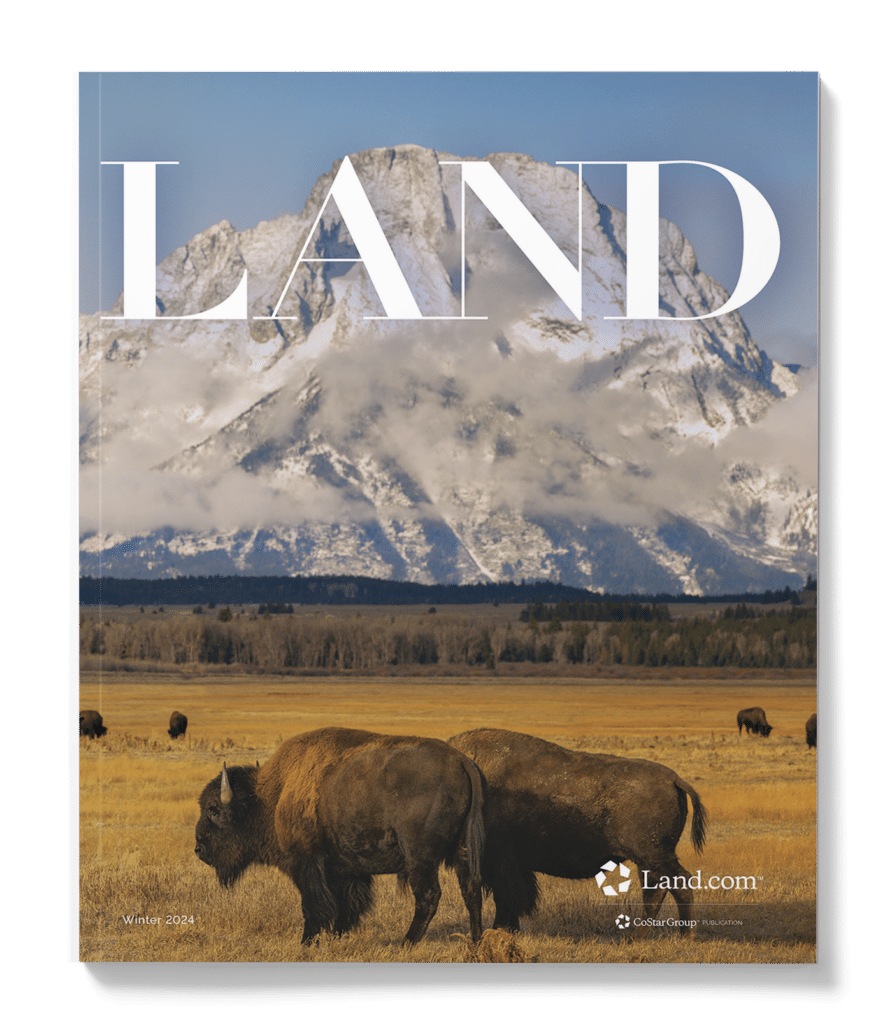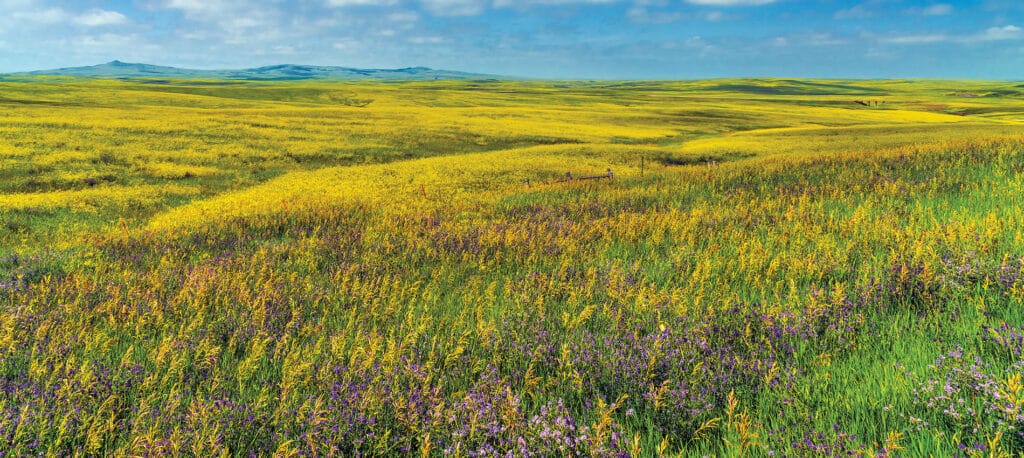
This article is featured in the Winter 2024 issue of LAND magazine. Click here to find out more.
To cope with the ecological ravages of the Dust Bowl, conservation agency professionals began importing plants from around the world. Some were used to provide ground cover or stem erosion, while others thrived in drought and produced abundant forage for livestock. Generally, the plants were introduced into the landscape for one specific purpose.
Less than a century later, the unintended consequences of these well-meaning introductions are evident across the nation. In many areas, introduced species have replaced native species, negatively impacting habitat and the wildlife that rely on it.
Beginning in the late 1960s, people began realizing what had been lost with native plant species and began working to restore the balance. The efforts gained momentum in the 1980s. Today, with changing land ownership and unpredictable weather patterns, more people than ever before are seeing the value and necessity of restoring rangelands with a diverse abundance of native plants.
I sat down with range professional and consultant Keith Pawelek, who before launching KP Wildlife and Habitat based in Kingsville, Texas, spent almost two decades on the executive leadership team of the Texas Native Seeds Program at the Caesar Kleberg Wildlife Research Institute, a privately funded research institute at Texas A&M University–Kingsville.
1. Why should people who are interested in wildlife, be equally interested in native plants?
KP: People tend to get really excited about animals, whether it’s wildlife or livestock, and overlook plants. As a result, I spend a lot of time harping on the value of plants.
Just like humans, all animals need three essential components for life—food, water and shelter. And meeting those needs really comes back down to the plants because those plants provide the food, shelter and sometimes the water that the animals require. As a result, the diversity and condition of the plants, especially the native plants, on any property determine the ultimate success of a landowner’s end goals.
2. What are the benefits of native plants in the landscape?
KP: As background, native plants, as defined by range scientists, are plants that populated the landscape of North America prior to European settlement. These North American plants evolved alongside North American wildlife, so there is a symbiotic or beneficial relationship between the native plants and all the native animals including the birds, insects and soil organisms. Plants native to a certain region, in the right combination, provide exactly what animals native to that region need.
Plus, those plants evolved with the weather conditions of that region. For instance, the plants native to South Texas, where I work a lot, are adapted to drought and more are resilient in the face of the extreme weather of that region.
Introduced species, on the other hand, were generally brought to America to address a single issue such as forage production for livestock or soil erosion. They were selected to be robust. Unfortunately, they do their job too well and displace most native species.
Introduced species create monocultures. When that happens, it impacts the wildlife usually negatively and can even shift the composition of the species on the landscape.
3. What are the challenges of restoring native plants on the landscape?
KP: As I mentioned before, introduced species were selected because they establish well, they’re competitive and highly productive. Those three characteristics are what make re-establishing natives so difficult.
To restore natives to the landscape, you have to remove the introduced species as best you can, using a variety of means ranging from mechanical treatments such as disking and herbicide treatments to prescribed fire for some species. This can take multiple treatments over multiple years.
When you do that, it uncovers the topsoil, which ranks alongside water as the most valuable component of rangeland and exposes it to the elements. Bare ground is at high risk for erosion from water and wind.
You also have to find ecotypic native seed. Ecotypic means a group of organisms within a species that has adapted to specific environmental conditions. The seed isn’t always easy to find and can be expensive.
Then, once you get the seed planted, it has to rain.
It’s a risky, expensive undertaking that takes a lot of patience.
And meeting those needs really comes back down to the plants because those plants provide the food, shelter and sometimes the water that the animals require.
4. How can people source native seed?
KP: I will start by saying not every native seed is native to where you are. So, the very first thing is learning what species you have—or should have—on your property to ensure that you’re not getting species that don’t belong there. Then, you have to pay careful attention to where those seeds are coming from.
Let’s take little bluestem. Little bluestem is little bluestem is little bluestem, right? But that’s not the case. When you take seeds from a plant that evolved in Kansas and plop it in the middle of Central Texas, it won’t thrive. In Central Texas, the soil, temperatures and annual rainfall are vastly different than what the Kansas seeds evolved with.
It’s essential to get seed from sources as close to your location as possible. My general rule of thumb? I’ll take seed originating from 200 to 300 miles east and west of where the seed will be plan ted, but onl y 150 t o 200 miles north and south, if possible. I’ll stretch the boundary farther east and west because generally sunlight and temperatures are similar farther along that axis than moving north and south.
With that said, some species perform well over large areas. Nuances like this one is why it makes sense to work with a range professional, either at an agency or a private consultant like me, who lives this day in and day out and can advise you.
When you start looking, though, a good starting place is the nearest USDA Natural Resources Conservation Service Plant Materials Center. NRCS is a federal agency that turned its attention to developing native seed sources back in the 1980s. Also, many states have programs like the Texas Native Seeds Program or the Iowa Ecotype Project that specialize in developing ecotypic, regionally adapted seed sources.
In the case of the NRCS and the state-level programs, each seed release has a specific name so it can be differentiated from all the other seed of that type. For instance, the Texas Native Seed Program and the NRCS Plant Materials Center have several releases of little bluestem; the South Texas release is Carrizo Germplasm, the Kansas release is Cimmaron, and the North-Texas Oklahoma release is OK Select. They’re regionally divided and adapted.
I wouldn’t plant Carrizo Germplasm if my property was near the Red River, nor would I plant OK Select in the South Texas brush country. Again, location matters.
Finally, some commercial seed companies have native seeds. The first question you should ask is, “Where did the seed come from?” The company representative should be able to tell you where it originated. If not, I would suggest looking elsewhere.
5. Knowing that every site is different what are the basic steps in rangeland restoration?
KP: While every site is different, each site follows a similar pattern.
Seed sourcing and the first step of site preparation take place simultaneously. You need to be thinking about your seed order one to two years out because, depending on what you need, native seed can be hard to come by. Some is seasonal. You need to talk with seed companies to ensure that they will have the seed you want when you’re ready to perform your restoration.
If you’re restoring rangeland and not just trying to diversify the plants on native rangeland, I recommend at least one application of herbicide on the site. It eliminates competition from the existing grasses and forbs, what some people mistakenly call weeds, especially for the water. Depending on the situation, it may take more than one application.
Once the site is cleared, the next step is planting. You can hire it done or do it yourself. If you’ve done any disking, I recommend waiting at least two months (unless you have a rain) before planting, so the soil can settle or compact. With native seed, you want the soil to be firm not fluffy.
I prefer a no-till native seed drill. They’re designed to place the seed at an ideal ¼-inch depth. Unlike crops, germinating native seeds don’t have the elongation to push through one or two inches of soil.
A no-till drill also ensures that the seed has plenty of soil contact. Soil contact is essential because that’s how moisture enters the seed and spurs germination.
Broadcasting seed is cheaper, but you lose a lot to birds, small mammals, wind and water run-off. If you choose to broadcast the land needs to be dragged with something heavy to maximize soil contact as much as possible.
While it’s tempting to think it’s over once you get your seed in the ground, you have to be vigilant. If it rains, the introduced seed and other competing plants that remain in the soil will germinate. They’re going to start growing within three days of the rain. The native species won’t start growing until five to seven days after the rain. That gives you a one-day window to treat the emerging competition with herbicide and give your natives a fighting chance.
Then you watch and wait. If the conditions are perfect, you may have a strong stand within a year, but that is the rare exception. It normally takes much longer—and one of the costliest mistakes I see people making is giving up at year two when they might see results at year three, four or five.
FOR MORE INFORMATION CHECK OUT THE FOLLOWING ONLINE RESOURCES:

